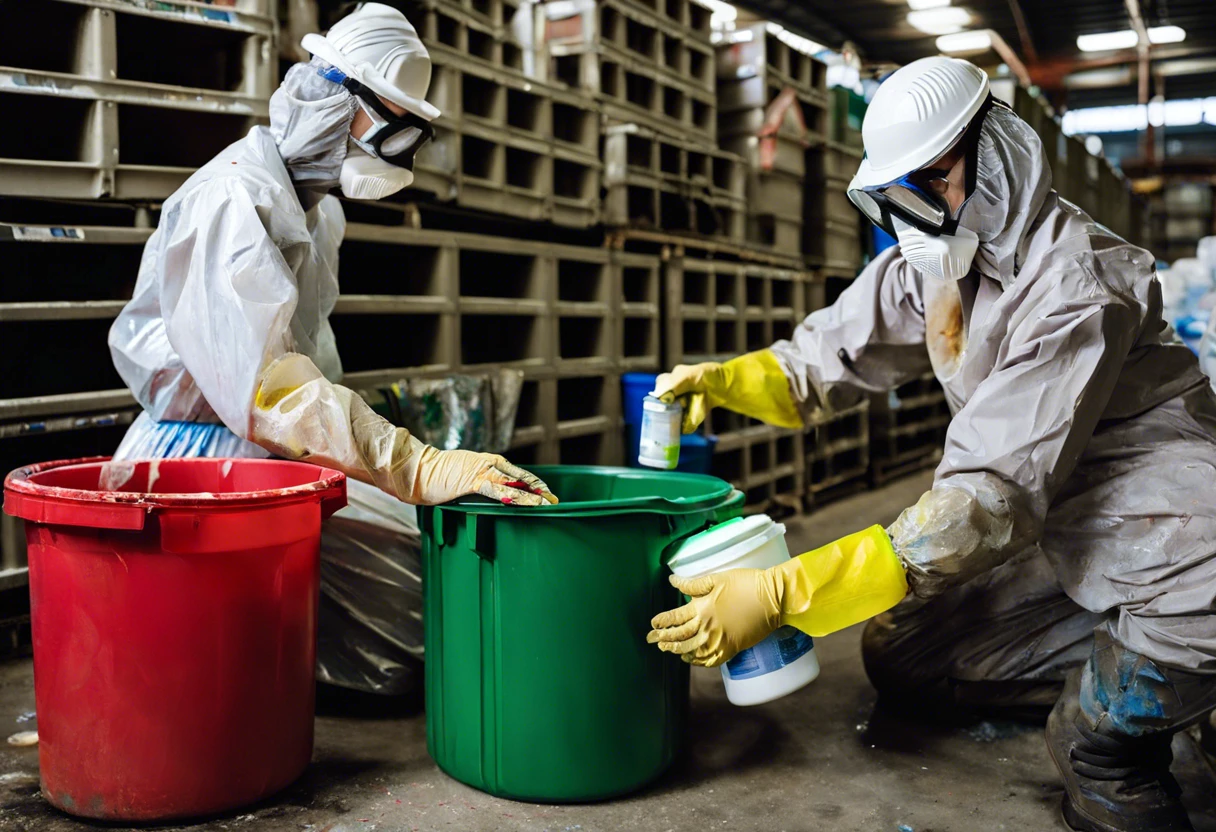Where to Dispose Of Paint Thinner?
Paint thinner’s like a magic potion for artists! It helps us mix colors and clean paint brushes, making our artwork shine.
Knowing where to dispose of paint thinner is super important. I once dumped it down the sink, thinking it’s harmless. What a mistake! It can hurt the environment, and now I follow proper disposal steps.
In this guide, we’ll cover the essentials of paint thinner disposal, including safety tips, step-by-step instructions, types of paint thinner, and common problems you might face. You’ll also learn how to clean your paintbrush with thinner and best practices for safe use.
Contents
- 1 Where to Dispose Of Paint Thinner?
- 2 What is Paint Thinner?
- 3 Essential Considerations Before You Start Disposing Of Paint Thinner
- 4 Step-by-step Guide to Disposing Of Paint Thinner
- 5 Types Of Paint Thinner and Their Disposal Requirements
- 6 Factors Affecting the Disposal Of Paint Thinner
- 7 Common Issues Encountered When Disposing Of Paint Thinner
- 8 Finishing Touches: Best Practices for Paint Thinner Disposal
- 9 Alternatives to Disposing of Paint Thinner
- 10 Regulations Surrounding Paint Thinner Disposal
- 11 Environmental Impact of Improper Disposal
- 12 Frequently Overlooked Disposal Options
- 13 Community Resources for Paint Thinner Disposal
- 14 Paint Thinner Collection Events
- 15 Frequently Asked Questions (FAQs)
- 16 Conclusion
- 17 Additional Resources
Where to Dispose Of Paint Thinner?
If you’re wondering where to dispose of paint thinner, check your local hazardous waste facility. Many cities have designated drop-off points. Never pour it down the drain or throw it in regular trash. Always follow local regulations for safe disposal! When working with different types of paint, you might also want to explore painting techniques for metal surfaces.
The Finishing Touch
A freshly painted wall is a blank canvas. The best way to bring your room to life is with a single piece of statement art that ties everything together.
Browse Wall Art at Big Wall DecorWhat is Paint Thinner?
Paint thinner is a volatile solvent that reduces paint viscosity or cleans brushes and equipment. It typically contains organic solvents like mineral spirits and acetone, with flash points of about 28°C (82°F) to 35°C (95°F).
Now, let’s discuss where to dispose of paint thinner. I remember the challenge of finding a safe place to dispose of it after a painting project.
I used it often to clean paint brushes after a long day of painting. When disposing of paint thinner, I realized it’s essential to find a reliable facility for safe disposal to protect the environment. If you’re wondering about other painting techniques and maintenance, you might want to explore bathtub refinishing options.
Essential Considerations Before You Start Disposing Of Paint Thinner
What do you need to know for disposal?
- Protective Gloves: You need durable gloves, like Nitrile Gloves (E.g., 888-100 From AMMEX). They’re essential for handling harmful chemicals safely.
- Sealed Containers: Use airtight containers, such as HDPE Plastic Containers (1 Gallon or 3.79 L). This prevents leaks during transport.
- Labeling Materials: Labeling tape (Like Avery 04605) is crucial for marking containers. This keeps things organized and informs others of the content.
- Safety Goggles: Choose ANSI-certified safety goggles (E.g., Edge Eyewear’s #ES5). Eye protection is vital when handling corrosive substances.
- Absorbent Materials: Use absorbent pads (Such As Booms From Sorbent Products Company). These help manage spills and ensure safe cleanup.
That covers key factors to consider before disposing of paint thinner. Let’s now take a look at the disposal process.
Also See: Can You Throw Paint in the Trash? Learn Safe Disposal

Step-by-step Guide to Disposing Of Paint Thinner
Here are steps for properly discarding paint thinner. Follow these actions for safe disposal.
The Finishing Touch
A freshly painted wall is a blank canvas. The best way to bring your room to life is with a single piece of statement art that ties everything together.
Browse Wall Art at Big Wall Decor-
Identify Local Disposal Regulations
Check local regulations on paint thinner disposal, as laws vary by region. Many areas have organizations that manage hazardous waste, so find out if you need a permit or specific guidelines.
You can often find this information on government websites or by calling local waste management services. Some municipalities hold designated days for hazardous waste drop-off, which can save you time.
-
Choose the Right Disposal Method
Look for appropriate disposal options! Many communities have hazardous waste collection sites for paint thinner. Some even host special collection events, making it easy to dispose of your materials responsibly. If you’re planning a large painting project like a mural, you might want to explore acrylic paint techniques.
I once poured paint thinner down the drain, thinking it was harmless. It caused a blockage and high cleanup costs! Avoid my mistake and always use designated disposal methods to prevent environmental damage and potential fines.
-
Transport Paint Thinner Safely
Use a secure, sealed container for transporting paint thinner to prevent leaks or spills. Label the container clearly to warn against unexpected handling during transport.
Never transport it in the passenger area of your vehicle. Keeping it in the trunk or truck bed minimizes exposure to you and reduces hazards from fumes during your drive.
-
Dispose at the Designated Facility
At the disposal facility, follow all posted guidelines and staff instructions. Place your container in the designated area—there’s often a specific spot for paint-related waste.
Don’t forget to obtain a receipt or confirmation for your records. This documentation could be useful for future inquiries about disposal methods.
So far we covered how to properly dispose of paint thinner. Let’s look at the different types and their disposal needs next.
Types Of Paint Thinner and Their Disposal Requirements
Let’s cover the types of paint thinner: mineral spirits, acetone, turpentine, and denatured alcohol.
-
Mineral Spirits
Mineral spirits are common for thinning oil-based paints. Dispose of them at a hazardous waste facility, as they can harm the environment if dumped improperly.
-
Acetone
Acetone is a strong solvent often used for cleaning. After use, check local guidelines for disposal, as many areas require it to be handled as hazardous waste.
-
Turpentine
This traditional paint thinner comes from pine trees. Dispose of it properly; it’s usually accepted at hazardous material collection events.
-
Denatured Alcohol
Denatured alcohol, made from ethanol, is great for cleaning brushes. It can often be disposed of in general waste, but confirm local regulations first.
I’ve found mineral spirits reliable for cleaning oil-based paints. Just ensure you dispose of them properly to protect the environment!
We’ve wrapped up the different types of paint thinner and how to dispose of them properly here. Let us turn our attention to the factors influencing paint thinner disposal.
Factors Affecting the Disposal Of Paint Thinner
What factors influence the disposal options for paint solvents and chemicals?
-
Regulations: Local laws dictate permitted disposal methods and locations for hazardous materials.
-
Environmental Impact: Potential harm to the ecosystem shapes the choices for safe disposal options.
-
Container Type: Used paint thinner containers may have specific disposal instructions based on their material.
-
Quantity: The amount of waste determines whether to use a recycling center or a special pickup service.
You should now have a good understanding of factors influencing paint thinner disposal. In the next part, we’ll discuss common disposal issues.

Common Issues Encountered When Disposing Of Paint Thinner
My friend tried tossing paint thinner in the trash. Not cool! Most landfills prohibit hazardous waste like that.
To dispose of it properly, check local guidelines. Many areas offer recycling centers for 1 gallon (3.785 Liters) of paint thinner, or you can use hazardous waste drop-off events.
Finishing Touches: Best Practices for Paint Thinner Disposal
After identifying proper disposal sites, securely seal expired paint thinner in a container for safe transport. Label it clearly to avoid confusion during disposal. It’s crucial!
Inspect containers regularly for leaks, especially if you use products like Klean Strip or Minwax. Ensure they’re intact, as even small drips can pose risks. Check every month!
As an expert, consider integrating a filtration system with activated charcoal. It effectively collects contaminants, enhancing the safe disposal of leftover paint thinner over 10 liters (2.6 Gallons). When working with clay projects, you might wonder about painting techniques before the material fully sets, so painting techniques for clay can provide additional guidance. Pay attention!
Alternatives to Disposing of Paint Thinner
If you find yourself with leftover paint thinner, consider these options instead of outright disposal.
The Finishing Touch
A freshly painted wall is a blank canvas. The best way to bring your room to life is with a single piece of statement art that ties everything together.
Browse Wall Art at Big Wall Decor- Reuse: If the paint thinner is still good, save it for future projects. It can be used for cleaning brushes or thinning paints later on.
- Mix and Store: Combine small amounts of leftover thinner into one container and securely store for future use. Just make sure to label it so you’ll remember what it is!
- Waste-to-Energy Programs: Some regions offer programs that convert paint thinner into energy. Check if your area participates in such initiatives!
Regulations Surrounding Paint Thinner Disposal
Understanding the regulations can simplify your disposal process.
- Federal Guidelines: The EPA classifies paint thinners as hazardous waste. Federal law requires you to dispose of them properly.
- State Regulations: Each state has different rules. Some might require permits for disposal, while others don’t.
- Local Laws: Check with your city or county. Many have specific hazardous waste disposal options or events.
Environmental Impact of Improper Disposal
Improper disposal can harm the environment significantly.
- Soil Contamination: Pouring paint thinner on the ground contaminates the soil and underground water supplies.
- Aquatic Life: If waste enters water sources, it can kill fish and other aquatic creatures.
- Air Pollution: Fumes from paint thinner can contribute to air pollution, affecting human health and wildlife.
Frequently Overlooked Disposal Options
Besides common disposal options, consider these lesser-known methods.
- Neighborhood Paint Exchange: Sometimes, neighbors or community groups share paint thinners for projects. Just ensure it’s properly labeled.
- Paint Thinner Recycling Programs: Some manufacturers offer recycling for leftover products. Check the brand’s website for info.
Community Resources for Paint Thinner Disposal
Working with local organizations can make disposal easier. Here are some resources you can check.
| Resource | Contact Info | Details |
|---|---|---|
| Local Hazardous Waste Management | (555) 123-4567 | Find drop-off days & locations. |
| Environmental Protection Agency (EPA) | www.epa.gov | Guidelines for disposal options and regulations. |
| Community Recycling Center | (555) 987-6543 | Regular collection events for hazardous waste. |
Paint Thinner Collection Events
Participating in collection events makes disposal easy! Here’s what you need to know:
- Frequency: Most cities hold these events quarterly or semi-annually. Check your city’s schedule.
- What to Bring: Only bring paint thinner in sealed containers, along with a valid ID for proof of residency.
- Event Locations: Check local government websites for addresses and any specific requirements for participation.
Also See: Can You Still Buy Lead-based Paint? Learn the Risks!
Frequently Asked Questions (FAQs)
What Are the Best Practices for Storing Paint Thinner?
To keep paint thinner safe, it’s crucial to store it in a cool, dry place away from direct sunlight. Doing this prevents vapors from building up and reduces the risk of fire hazards, which can happen if the temperature exceeds 40°C (104°F).
Can I Pour Paint Thinner Down the Drain?
No, you shouldn’t pour paint thinner down the drain. This method harms the environment and can cause blockages in your plumbing. Plus, it violates regulations in many locations that prohibit this practice to protect water supply systems. If you’re working on a painting project and need proper disposal guidance, safe paint disposal techniques can help you manage hazardous materials responsibly.
What Should I Do if I Have Leftover Paint Thinner?
If you have leftover paint thinner, take it to a designated hazardous waste facility. Proper disposal minimizes environmental impact and protects health, ensuring dangerous chemicals don’t contaminate soil or water. Look for local disposal guidelines or events to drop it off safely. When handling paint-related materials, you might also want to explore painting tile renovation techniques for future home improvement projects.
Are There Alternatives to Paint Thinner?
Yes, there are several alternatives to paint thinner, such as mineral spirits or odorless solvents. Alternatives often reduce health risks and are less flammable, making them safer choices for cleanup and thinning paint instead of traditional thinner products. If you’re looking to explore more creative painting techniques, you might want to discover accent wall painting strategies.
How Do I Know if a Disposal Facility Accepts Paint Thinner?
You can verify if a disposal facility accepts paint thinner by checking their official website or calling directly. Facilities often list acceptable items. Many municipalities also provide guidelines on hazardous waste that detail proper disposal options for paint thinner. If you’re looking to dispose of paint thinner safely, you might want to explore professional painting disposal techniques.
Conclusion
That brings us to the end of our discussion on where to dispose of paint thinner.
We covered various items such as types of paint thinner, essential considerations before disposal, and best practices to ensure safe disposal methods. Hopefully, I was able to impart some of my experience on how you can properly dispose of paint thinner by using recycling centers, hazardous waste facilities, or following local regulations.
For further insights and guidance, visit Paint Answers.
Additional Resources
- Loomis, A. (2011). Figure Drawing for All It’s Worth. New York, NY: Titan Books.
- Facts About… – Maryland Department of the Environment
Isabella is a Filipino-American art writer and critic specializing in contemporary painting, blending her Filipino heritage with global art trends. She holds a BFA from California State University, Long Beach, and a Minor in Art History from the University of the Philippines. Isa has experience as a Gallery Assistant, Art Appraisal Specialist, and Social Media Creative for Art & Design.
Disposal, Misc.









